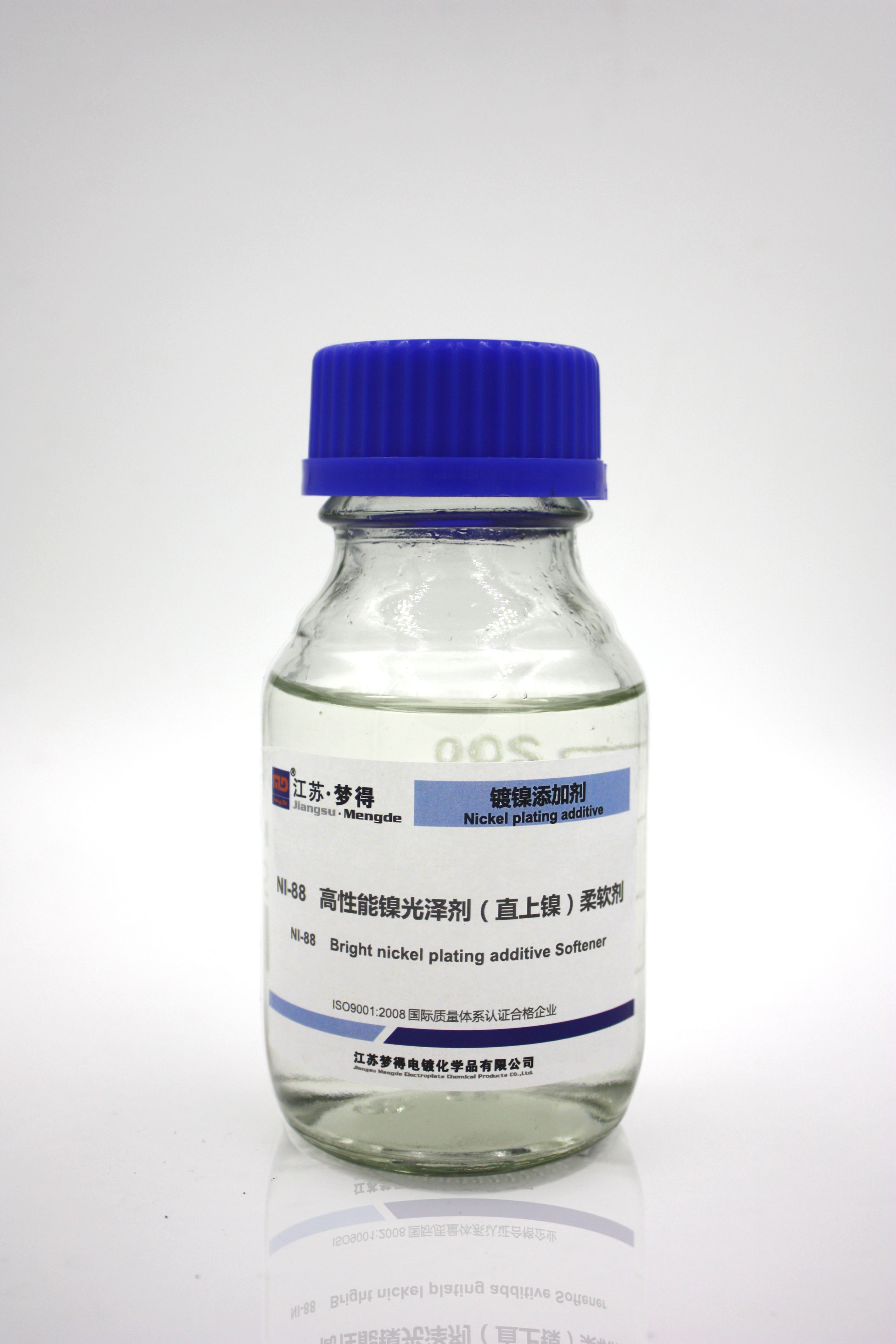NI-88 series, bright nickel plating process, nickel plating
brighteners, ready to use, rack plating
Applications and advantages
- Used in chromium, bronze, gold, and silver plating as the base deposit under bright nickel layer.
- Has excellent covering and throwing power, especially in LCD area.
- Bright white and esthetic coating with good flexibility.
- High-speed brightening and good leveling.
- Easy to operate and control; has good tolerance against impurities
in bath solution
Bath Composition and Working Conditions
| Composition of the plating solution and the working condition | Range | Standard |
| Nickel Sulfate | 240-300g/L | 270g/L |
| Nickel Chloride | 45-75g/L | 60g/L |
| Boric Acid | 37-53g/L | 45g/L |
| NI-88 Main Brightener | 0.5--1ml/L | 0.7ml/L |
| NI-88 Softener | 8-12 ml/L | 10ml/L |
| MT-80 Wetting agent | 2-4ml/L | 2ml/l |
| pH | 3.5-5.0 |
| Temperature | 50-60℃ |
| Cathode current density | 2.2-10 A/dm² |
| Agitation | Air agitation |
Preparation of bath solution
- Add half volume of water into the standby bath. Heat the water to
60-70℃, add the needed amount of nickel sulfate and nickel chloride.
Blend until all is dissolved.
- Use 10% dilute sulfuric acid to adjust the pH value to 3.0; add
2-3ml/L hydrogen peroxide (30%); blend for half an hour; adjust the
pH value to 5.5-6.0 with 4% sodium hydroxide solution; heat to
65-70℃; keep the temperature for half an hour.
- Sustain the temperature to 50-55℃; add 2-3g/L activated carbon; blend for half an hour; filter into
the plating bath.
- Dissolve the boric acid separately with boiling water; filter into
the plating bath.
- Add water to the required volume; use 10% dilute sulfuric acid to
adjust the pH value to 3.0; sustain the temperature at 55℃. Electroplate with the corrugating board as the cathode at
DK≈0.3A/dm2 until corrugating board is silver gray at LCD areas.
- Take small amount of plating solution and check with hull cell
test. If not normal, continue to electrolyze the solution until it
is normal.
- Add calculated amount of additives into the nickel bath. Engage in
trial electroplating until normal.
The functions and replenishment of the additives
- NI-88 make up solution agent helps decrease the internal stress of
the deposit, and enables a favorable performance of the coverage
percentage in LCD areas. Continuous filtration with activated
carbon could only remove a small fraction of NI-88, as well as
electrolyzing, which is about 80-120 ml/KAH.
- Do add NI-88 make up solution agent, NI-88 supplementary, wetting
agent together to help function when making up nickel solution.
NI-88 supplementary consumption amount is 100-150ml/KAH.
- MT-80 Wetting agent helps sustain the tension of the plating
solution surface, so as to prevent pinholes. MT-80 is suitable for
air agitation as it is a low foam surfactant.
Attentions
- The nickel sulfate, nickel chloride, boric acid selected into the
solution shall be as pure as possible to enable a favorable
performance.
- Boric Acid has low solubility. Filter it by activated carbon first
to prevent the precipitation of boric acid then dissolve it with
boiling water separately and dump into the bath.
- Corrugated board: Wave-shape board, iron plate is workable.
Nickel-plate all the surface before the first use.
- Electroplate the bath solution. First electroplate with the
high-current DK≈3A/dm2 for 1-2 minutes, then with DK≈0.3A/dm2. If coating turns black during the process of electroplating,
grind, and then electroplate until the LCD of the corrugated board
turns silver gray.
Packing and Storage
Packed in 25kg plastic drums, stored in cool and dry place.
Product Display



Declaration:
The recommendations among the content of this instruction is based
on the trials and tests, as well as the related documents which are
credible to our company. As the operating practices and equipment
differ from each other, we will not hold responsible for any
negative outcomes. The content of this instruction could not serve
as evidence of copyright infringement.


